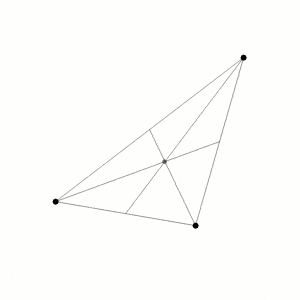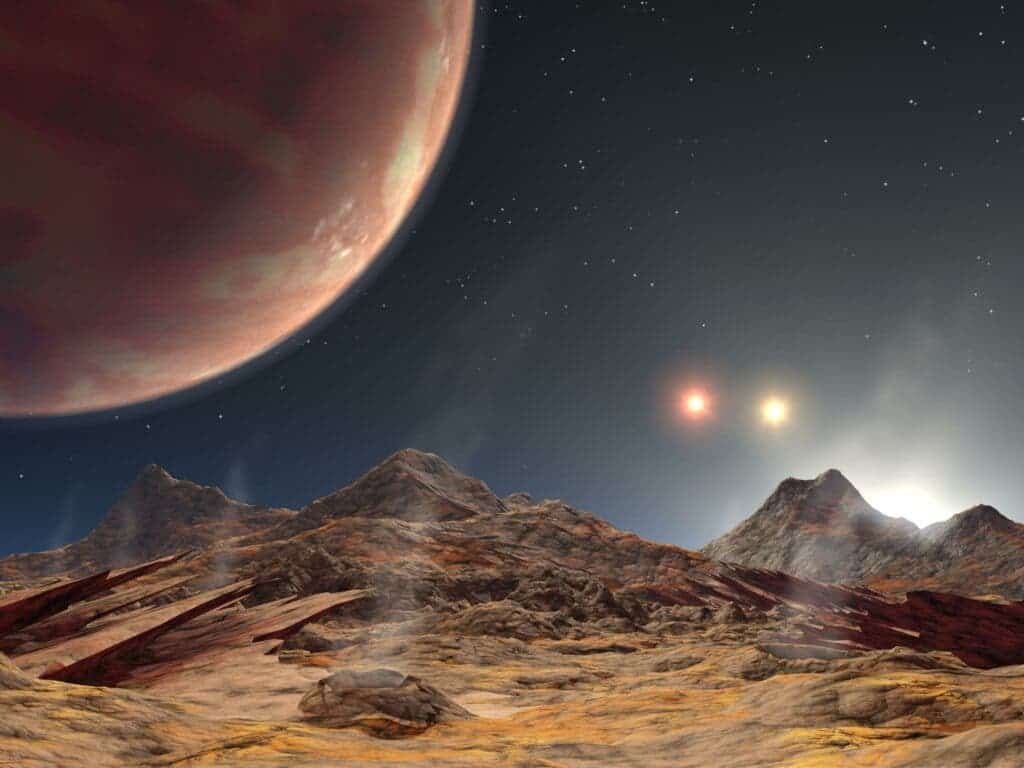Multiple star systems are different from our single-starred solar system, but they are common across the galaxy. One of the first binaries discovered was Mizar in the Big Dipper in 1650 by Giovanni Battista Riccioli. Since then, astronomers have discovered plenty of systems with two or more stars. The vast majority of the ones that have been discovered so far have two stars, but some have three or even four stars.
But do these systems also have planets orbiting these stars? Now that’s a very different question.
The idea of a planet orbiting multiple stars sounds a bit sci-fi. In fact, fiction has embraced the possibility many times. The most famous is Star Wars’ Tatooine, but there are other examples. Asimov’s Nightfall displays the system of the Lagash planet, orbiting among six stars. But fiction aside, is it possible for a planet to orbit such systems or even be habitable?

Many bodies are a problem
The first issue is finding a good orbit. Multiple body systems are complex and chaotic, and having a stable orbit around more than one star is pretty challenging. Two-body systems (say, when there’s one star and one planet) are relatively easy to understand, but when you add a third body to the system, now there is an “action/reaction” between three bodies which is not a simple thing to write in equations and results in a chaotic system. This is the famous three-body problem.
If you have four or even more bodies, the system gets even more complicated with more equations. This type of system is chaotic, meaning changing the initial conditions even slightly will have great consequences on their motion.

A way to solve the three-body problem is to pretend it is a two-body system considering just the most massive objects. However, this is not ideal especially if you want to precisely predict eclipses.
Things got a lot easier with computers as you can now compute orbits instead of just solving equations. For instance, computers can be used to find the best place to put a telescope, find solutions for satellite orbits in other planes, compute the orbits of asteroids, planets, and so on. For instance, some complicated solutions to the three-body problem only appeared in 2013 with Milovan Šuvakov, V. Dmitrašinović providing 13 solutions.

What this tells us is that you need very specific conditions for a planet to coexist orbiting two or more stars. The more stars you add, the more unlikely it gets that a plant could last in the conditions. Asimov’s Nightfall planet called Lagash is therefore pretty unlikely to exist, as it orbited six stars (though not necessarily impossible). The planet in the story would have to be in a binary orbit with a red dwarf, both of them orbiting the central star. The other 4 stars should be orbiting the central system, forming pairs of binaries that dance together. According to the story, Lagash’s daytime lasts 2,049 years which cannot be correct — the maximum day for such a complex system would be 2 months, according to estimates from an astrophysicist.
The possibilities of a long daytime and description of the system were tested by astrophysicist Sean Raymond in his blog PlanetPlanet which includes other fictional planets. A system even more complex than that was presented in the first season of Star Trek: Picard, an 8-star system presented as known by the Romulans as an ancient system. The octonary is described as really rare — no wonder, the difficulty to solve a 9-body (planet plus the 8 stars) problem is quite scary. The only possible explanation presented in the show was that the system had to be artificial, as it’s naturally nearly impossible to exist. It’s not necessarily wrong if you want to pretend like it was built by a civilization instead of naturally forming, but otherwise, pretty questionable.
Living with giants
So then what is the best (read: most realistic) orbit for a planet to survive among multiple stars?

Planets can survive around binary systems by orbiting each star or orbiting both stars. Orbits where the planet can “see the stars” when it’s at the center of the orbit are more stable, they are called circumbinary planets. This is what we picture in our minds at first — planets like Tatooine. In fact, the first circumbinary was detected in 2011 by the Kepler mission called Kepler-16b. The planet is not habitable, a cold gaseous planet.
Another stability issue is the inclination’s orbit. If the inclination is too high with respect to the binaries, the orbit becomes more eccentric, risking getting too close to the stars — this is called the Lidov-Kozai mechanism. The Octonary planet and Lagash would be very difficult to sustain, but Tatooine is much easier.
A notable example is the HD 188753 triple star system. The triple star system was first discovered, and then, in 2005, a candidate planet orbiting the primary star of the triple star system was announced. This isn’t the first known planet in a triple star system — for example, the planet 16 Cygni Bb had been discovered earlier, orbiting one of the components of a wide triple system also in the constellation of Cygnus.
“Suns-set”
What would life be like for those living in a multiple-star system? Let’s once again start with something like Tatooine, in a binary system. As the most simple system, with a circumbinary orbit, it is quite stable. Provided that the orbit is not crazy, the next criterion is habitability.
So far we know from the Kepler Mission that more than 2100 multiple star systems, mostly binaries and some triple star systems, exist. In this list, around 8% of Kepler’s detections have a planet-hosting system. Kepler 64 is one in a quadruple system. Very recently, the Gaia dataset from the European Space Agency showed even more stars that could be in binary systems.
In 2014, Müller and Haghighipour calculated the different habitable zones for some of the multi-systems found by Kepler. The results rely on each star’s radiation reaching the exoplanet’s atmosphere. This leaves two regions of the habitable zone: the narrow habitable zone, where the greenhouse effect protects the planet from freezing, and the empirical habitable zone where the planet’s climate could range from Venus-like to early-Mars-like — i.e. it could be really hot and brutal or an environment that could reasonably sustain liquid water.
Triple systems are more complicated. If the planet maintains a circum-orbit (an orbit around both stars), it is not so different from the separations of habitability we see with a single star. But things get weird for complicated orbits between the stars. The stars can make the habitable zone vary depending on their movement with respect to the larger stars.
Even more complex orbits can be measured, the case of a Figure-Eight Orbit, for instance, makes it rather unlikely for a planet to find a stable orbit to survive in such an environment.
We still need to find more planets living in a multiple star system, then try to estimate habitability. Tatooine seems possible, the other examples not so much, very exotic orbits would be necessary. It would be nearly impossible to sustain carbon-based life on planets like this. The beings on such a planet would have to be highly adapted to this environment. For a tree to evolve and live within 2-month daytime is understandable, they do something similar to change their leaves for the ‘winter’. But for beings like mammals, survival here wouldn’t be quite so easy – if it could happen at all.






